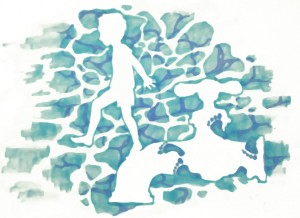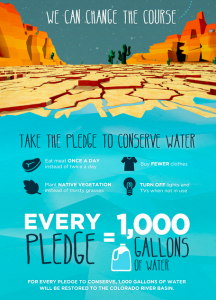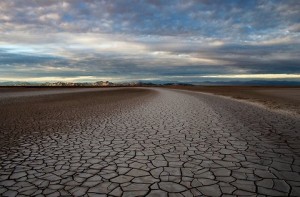
The Colorado River was once a symbol of the majesty of the American West. The brute force of its waters carved the Grand Canyon, a national treasure that Theodore Roosevelt called “the one great sight which every American should see.” Beginning in the peaks of the Rocky Mountains, it wound its way southwest, passing through seven states before entering Mexico and emptying into the Gulf of California. In contrast to the arid lands of the Southwest, its banks were verdant, an oasis for dozens of species of birds and fish.
Today, however, the once-lush Colorado River Delta is now barren and desiccated. For nearly a decade, the mighty river has not reached the sea, petering out to a mere trickle and leaving its marshlands dry. The culprit lies upstream, where 30 million Americans have diverted and dammed the river for their own use. The water is used not only to support the burgeoning populations of cities like Los Angeles, Las Vegas, and Phoenix, but also to provide irrigation for over 3.5 million acres of cropland. Without intervention, it seems unlikely that the flow of the Colorado River will return to its natural state anytime soon.
Unfortunately, the Colorado River is not the only body of water suffering from a human population’s large water footprint. Policymakers coined the term “water footprint” to capture the total volume of freshwater used by individuals, communities, and businesses. When people hear the term, most think of watering their lawns, brushing their teeth, or washing their clothes. These are all examples of direct uses of water, but they comprise only one small part of a water footprint. The larger, unseen portion of a water footprint is indirect use, which consists of all the water used to produce the goods and services that an individual uses.
The full scope of indirect water use is difficult to grasp, mostly because consumers never see the water used to make their products. But groups like the GRACE Communications Foundation are working to expose the shockingly large water footprints of some common goods. A single slice of pizza, for example, requires 42 gallons of water. Surprised? Consider the ingredients. Water is needed to grow the wheat that makes the flour; water is needed to turn that flour into dough. There can be no cheese without a cow, which of course requires drinking water, and the tomatoes in the sauce would have withered without regular watering. All of that water is hiding behind the production of that one slice of pizza – and pizza is hardly the worst offender.
A dozen eggs require 636 gallons of water; a simple cotton T-shirt uses up 700 gallons. Animal products are one of the most egregious contributors to a person’s water footprint, with beef clocking in at 8977 gallons of freshwater per pound.
These statistics can leave consumers feeling overwhelmed and helpless – short of buying a chicken coop, how can they control the water footprint of their breakfast omelet?

Image courtesy of Change the Course.
The key here is conscious consumption. By choosing to reduce the amount of meat, eggs, and other animal products in their diets, consumers can lower their indirect water footprints. In terms of liquids, tea consumes 9 gallons of water to coffee’s 37 gallons, making tea the caffeinated beverage of choice for a water-conscious consumer. In choosing produce, consumers should pay attention to season and source. A Connecticut native can enjoy local heirloom tomatoes in late August at a relatively low water footprint, but tomatoes in the dead of winter are likely coming from distant, potentially water-threatened areas.
Professor Shimon Anisfeld of the Yale School of Forestry and Environmental Sciences has witnessed firsthand the regional nature of water use. Anisfeld, who studies human impacts on rivers in the Connecticut area, noted that “many rivers in the state are depleted relative to their natural flows,” not unlike the ailing Colorado River. However, he continued, “in contrast to states like Colorado and California where most water is used for irrigation of crops, in Connecticut most water goes to household use.” For Connecticut residents, then, reductions in individual use like shortening showers and fixing leaky faucets are all the more important. “The population of Connecticut certainly has the power to determine how much water they use; it is the cumulative effect of individual actions that will keep Connecticut’s streams flowing,” Anisfeld said.

Image courtesy of Peter McBride.
The freshwater team at National Geographic thinks the same principle of motivated individual action can restore the flow of the Colorado River. Together with the Bonneville Environment Foundation and Participant Media, National Geographic has created the “Change the Course” campaign. On its website, people can pledge to reduce their water footprints directly or indirectly. Pledges include taking shorter showers, choosing vegetables over meat once a week, and seeking locally-sourced meals. For every pledge, corporate partners of the campaign will sponsor projects that restore flow to the Colorado River on the scale of 1,000 gallons of water per pledge. The benefits of a pledge are thus two-fold: on the one hand, sponsors will target improved water conservation and management strategies. On the other, individuals from Connecticut to Colorado will reduce their water footprints, either directly to ensure that their local rivers maintain a healthy flow, or indirectly to decrease their global water impact.
Such efforts are especially important as climate change imposes its own challenges to water conservation. A number of recent studies show that climate change will likely decrease the Colorado River’s flow by 5 to 35 percent; precipitation from the Rockies will lessen, while rising temperatures will increase the rate of evaporation. In the face of these worsening conditions, it is little surprise that southwestern states are already experiencing unprecedented droughts, forcing citizens, farmers, and policymakers to take a critical look at their water consumption. Restoring the Colorado River will not be easy, but it is important to remember that every drop counts.
Want to restore 1,000 gallons of water to the Colorado River? Sign up at www.changethecourse.us or text “River” to 77177 and make your pledge to reduce your freshwater footprint.
Cover Image: The Colorado River, which stretches 1450 miles over seven states, was once a stunning picture of untamed natural beauty.
Image courtesy of Frans Lanting.
